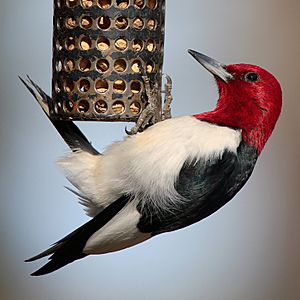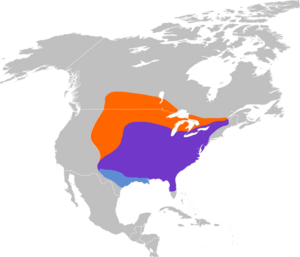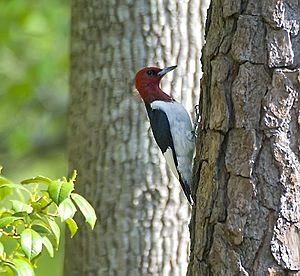Red-headed woodpecker facts for kids
Quick facts for kids Red-headed woodpecker |
|
|---|---|
 |
|
| At a bird feeder in Rondeau Provincial Park, Ontario | |
| Conservation status | |
| Scientific classification | |
| Genus: |
Melanerpes
|
| Species: |
erythrocephalus
|
 |
|
| Approximate distribution map
Breeding Year-round Nonbreeding |
|
| Synonyms | |
|
Picus erythrocephalus Linnaeus, 1758 |
|
The red-headed woodpecker (scientific name: Melanerpes erythrocephalus) is a medium-sized bird. You can find it in North America, especially in southern Canada and the eastern-central United States. These woodpeckers like open areas to live and raise their families.
It is important not to confuse the red-headed woodpecker with the red-bellied woodpecker. While they are similar in size, the red-bellied woodpecker has a bright orange-red head and neck. Its back is black and white, unlike the solid black back of the red-headed woodpecker. The red-bellied woodpecker also has a light reddish color on its lower belly.
Contents
About the Red-Headed Woodpecker
Naming and History
The red-headed woodpecker was first described by Mark Catesby, an English naturalist. He wrote about it in his book The Natural History of Carolina, Florida and the Bahama Islands between 1729 and 1732. He called it "The Red-headed Wood-pecker."
Later, in 1758, a Swedish scientist named Carl Linnaeus gave the bird its scientific name. He called it Picus erythrocephalus. The name erythrocephalus comes from two old Greek words. Eruthros means "red," and kephalos means "headed." So, the name means "red-headed."
This woodpecker is now part of a group of birds called Melanerpes. There is only one type of red-headed woodpecker; it does not have different subspecies.
What They Look Like
Red-headed woodpeckers have three main colors. Their back and tail are black, and their belly and rump (lower back) are white. Their head and neck are bright red. Their wings are black with white patches.
Both male and female adult red-headed woodpeckers look the same. Young woodpeckers have similar markings, but their heads are gray instead of red.
These woodpeckers are medium-sized. They are about 19 to 25 centimeters (7.5 to 9.8 inches) long. Their wingspan is around 42.5 centimeters (16.7 inches). They usually weigh about 76 grams (2.7 ounces).
Red-headed woodpeckers make a tchur-tchur sound. They also drum on trees to mark their territory.
Red-Headed Woodpecker Behavior
Food and Eating Habits
The red-headed woodpecker is an omnivore. This means it eats both plants and animals. Its diet includes insects, seeds, fruits, berries, and nuts. Sometimes, they might even eat small rodents or the eggs of other birds. About two-thirds of what they eat comes from plants.
These woodpeckers are known for storing food. They hide food in tree holes, cracks, and under tree bark. This helps them have enough food all year long. Only a few other woodpecker species do this.
Reproduction and Life Cycle
Finding a Mate
During the breeding season, a male red-headed woodpecker finds a territory. He calls and drums to attract a female. Once a male and female pair up, they usually stay together for several breeding seasons. They are thought to be monogamous, meaning they have only one mate. However, sometimes a male might have more than one mate, which is called polygyny.
Nesting Habits
Red-headed woodpeckers are very protective of their territory. They might even destroy the nests and eggs of other birds nearby. The female chooses where to build the nest. She might pick a natural hole, an old nest, a fence post, or a dead tree.
If there isn't a hole already, both parents will dig one. The male does most of the work. They usually choose dead trees or utility poles. These nest holes are often between 2.45 and 24.5 meters (8 and 80 feet) above the ground.
In early May, the female lays four to seven white eggs. Both parents take turns keeping the eggs warm. The female sits on the eggs during the day, and the male takes over at night. The eggs hatch after about two weeks.
Caring for Young
Both parents care for the young birds after they hatch. The young stay in the nest for about 27 to 31 days until they are ready to fledge. Fledging means they are old enough to fly.
After the first group of young birds leaves the nest, the parents might start a second group. They will still care for the first group, but those young birds won't need as much help. The second group might use the same nest or a new one.
Young woodpeckers are good flyers when they fledge. Most can find food and care for themselves quickly. They usually leave their parents' territory within a few weeks. If a young bird stays too long, the parents might chase it away. Red-headed woodpeckers can raise two groups of young in one nesting season.
Migration
By late October, red-headed woodpeckers from northern areas start to fly south. They spend the winter in warmer parts of their range. Most return to their breeding areas by late April. Woodpeckers living in the southern parts of the range might not migrate at all.
Conservation Status
The red-headed woodpecker is currently listed as a species of "least concern" by the International Union for Conservation of Nature (IUCN). This means their population is not in immediate danger. However, they were listed as "near threatened" in 2004 because their numbers dropped by about 65.5% over 40 years.
From 1966 to 2015, their population continued to decline in some areas. The main reasons for this decline are:
- Loss of their natural living areas (habitat).
- Not enough dead trees for them to make nests.
- Less food available.
- Competition for nest holes with other birds, especially the European starling, which is an invasive species.
Efforts to manage their habitat have helped to stabilize their numbers. The red-headed woodpecker was once very common in Canada and the eastern-central United States. However, long-term declines have led to them being listed as threatened in Canada and several US states.
Some important bird areas in Canada where red-headed woodpeckers are found include:
- Cabot Head, Ontario
- Carden Plain, Ontario
- Long Point Peninsula and Marshes, Ontario
- Point Abino, Ontario
- Port Franks Forested Dunes, Ontario
- Kinosota/Leifur, Manitoba
- Along the South Saskatchewan River in Saskatchewan
See also
 In Spanish: Carpintero de cabeza roja para niños
In Spanish: Carpintero de cabeza roja para niños



